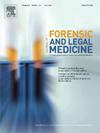Blood acetone concentrations in forensic autopsies are related to the food residue in stomach
IF 1.2
4区 医学
Q3 MEDICINE, LEGAL
引用次数: 0
Abstract
Elevated blood acetone concentrations are used as an initial marker to identify ketoacidosis in forensic autopsies. However, blood acetone concentrations may not reflect the status of ketoacidosis. This study aimed to clarify the significance of measuring blood acetone concentrations in routine forensic autopsies. We studied 367 forensic autopsies to determine the relationships between blood acetone concentrations and blood ethanol concentrations, blood biochemical laboratory test values, as well as the physical factors that may affect blood acetone concentrations. Blood acetone concentrations showed no correlations with blood ethanol concentrations, blood HbA1c levels, blood C-reactive protein levels, amount of gastric content, and body mass index. Blood acetone concentrations were significantly higher in subjects without residual food in their stomach. Binomial logistic regression analysis revealed that the increase in blood acetone concentrations was significantly associated with the absence of gastric residue. Our findings indicated that increased blood acetone concentrations were related to the absence of food residues in the stomach at the time of death. In forensic autopsy cases with elevated blood acetone concentrations, the presence or absence of residual food in the stomach should be considered.
法医尸检中的血丙酮浓度与胃中的食物残渣有关
升高的血丙酮浓度被用作法医尸检中识别酮症酸中毒的初始标记。然而,血丙酮浓度可能不能反映酮症酸中毒的状态。本研究旨在阐明测定血丙酮浓度在常规法医尸检中的意义。我们研究了367例法医尸检,以确定血丙酮浓度与血乙醇浓度、血液生化实验室检测值之间的关系,以及可能影响血丙酮浓度的物理因素。血丙酮浓度与血乙醇浓度、血HbA1c水平、血c反应蛋白水平、胃内容物量和体重指数无相关性。在胃中没有残留食物的受试者中,血液中的丙酮浓度明显更高。二项logistic回归分析显示,血丙酮浓度的升高与胃残渣的缺失有显著的相关性。我们的研究结果表明,血液中丙酮浓度的增加与死亡时胃中没有食物残留物有关。在血液丙酮浓度升高的法医尸检病例中,应考虑胃中是否存在残留食物。
本文章由计算机程序翻译,如有差异,请以英文原文为准。
求助全文
约1分钟内获得全文
求助全文
来源期刊

Journal of forensic and legal medicine
MEDICINE, LEGAL-
CiteScore
2.70
自引率
6.70%
发文量
106
审稿时长
57 days
期刊介绍:
The Journal of Forensic and Legal Medicine publishes topical articles on aspects of forensic and legal medicine. Specifically the Journal supports research that explores the medical principles of care and forensic assessment of individuals, whether adult or child, in contact with the judicial system. It is a fully peer-review hybrid journal with a broad international perspective.
The Journal accepts submissions of original research, review articles, and pertinent case studies, editorials, and commentaries in relevant areas of Forensic and Legal Medicine, Context of Practice, and Education and Training.
The Journal adheres to strict publication ethical guidelines, and actively supports a culture of inclusive and representative publication.
 求助内容:
求助内容: 应助结果提醒方式:
应助结果提醒方式:


